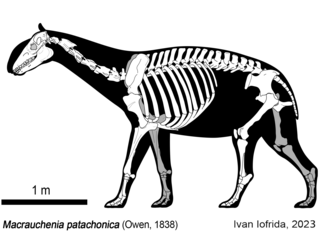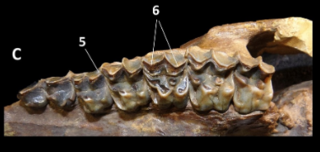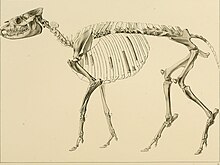
Litopterna is an extinct order of South American native ungulates that lived from the Paleocene to the end of the Pleistocene-early Holocene around 63 million-12,000 years ago, and were also present in Antarctica during the Eocene. They represent the second most diverse group of South American ungulates after Notoungulata. It is divided into nine families, with Proterotheriidae and Macraucheniidae being the most diverse and last surviving families.

Xenorhinotherium is an extinct genus of macraucheniine macraucheniids, closely related to Macrauchenia of Patagonia. The type species is X. bahiense.

Neolicaphrium is an extinct genus of ungulate mammal belonging to the extinct order Litopterna. This animal lived from the Late Pliocene (Chapadmalalan) to the Late Pleistocene (Lujanian) in southern South America, being the last survivor of the family Proterotheriidae.
Cullinia is an extinct genus of litoptern, an order of South American native ungulates that included horse-like and camel-like animals such as Macrauchenia. It is only known from fragmentary remains. Cullinia levis is known from Chasicoan remains found in the Arroyo Chasicó Formation of Argentina, and remains from the Brazilian state of Acre and the Huayquerian Ituzaingó Formation have been assigned to Cullinia sp..
Proterotherium is an extinct genus of litoptern mammal of the family Proterotheriidae that lived during the Late Miocene of Argentina and Chile. Fossils of this genus have been found in the Ituzaingó Formation of Argentina, and the Galera Formation of Chile.
Promacrauchenia is an extinct genus of macraucheniids that lived during the Late Miocene to Late Pliocene epochs of what is now Argentina and Bolivia. It belongs to the subfamily Macraucheniinae, which also includes Huayqueriana, Macrauchenia, and Xenorhinotherium. Fossils of this genus have been found in the Ituzaingó, Andalhuala, and Cerro Azul Formations of Argentina.
Llullataruca is an extinct genus of macraucheniid litoptern. It lived during the Middle Miocene of what is now Bolivia.
Olisanophus is a genus of extinct litoptern from the late middle Miocene of southern Bolivia. It was named in 2020 by Andrew McGrath and colleagues, for two distinct species from the same deposits of an unnamed formation of the Honda Group. The type species is O. riorosarioensis, known from elements of the partial upper and lower left and right dentitions and possibly a partial mandible, and the referred species is O. akilachuta, known for 6 teeth. Some intermediate material from the same deposits was referred to Olisanophus sp., not showing diagnostic features of either species. Both species were recovered together in a phylogenetic analysis, where they were sister taxa to a group of Diplasiotherium and Mesolicaphrium.
Mesolicaphrium is a genus of extinct litoptern from the late middle Miocene of southern Colombia. It was named in 2020 by Andrew McGrath and colleagues, for the species previously classified as Prolicaphrium sanalfonensis from the La Victoria and Villavieja Formations of the Honda Group, Colombia. The type species is M. sanalfonense, known from the jaw symphysis and two right mandibular rami, and teeth. Mesolicaphrium is derived from the similarity to the names Prolicaphrium and Neolicaphrium, and being in between both taxa in age. The taxon was recovered in a phylogenetic analysis as the sister taxon of Diplasiotherium, closely related to Olisanophus.
Neodolodus is a genus of extinct litoptern from the late middle Miocene of southern Colombia. It was named in 1986 by Hoffstetter and Soria, for the species Neodolodus colombianus from the Castilletes Formation and the La Victoria and Villavieja Formations of the Honda Group. The type species N. colombianus is known from a right mandibular ramus, teeth, and part of the fore- and hindlimbs. Neodolodus has been classified as a species of Prothoatherium or Lambdaconus, but was recognized as a distinct genus by McGrath and colleagues in 2020. The taxon was recovered in a phylogenetic analysis as the sister taxon of Protheosodon, between other proterotheriid genera like Picturotherium and Anisolophus.
Uruguayodon is an extinct genus of proterotheriid from the middle Pleistocene of Uruguay. It is known from the type and only species U. alius, named by Corona and colleagues in 2019 for dentaries and a partial postcrania from the Raigón Formation. Uruguayodon represents one of the latest occurrences of Proterotheriidae, with only Neolicaphrium representing other remains from the Pleistocene to possibly Holocene.

Protheosodon is an extinct genus of proterotheriid litoptern. It lived from the Late Oligocene to the Early Miocene in what is now Argentina and Colombia.
Pseudobrachytherium is an extinct genus of proterotheriid from the Late Miocene of Uruguay. It is only known from the type species P. breve, named in 2020 by Corona and colleagues for an almost complete skull found in the greenish pelite of the San Pedro member of the Camacho Formation, which is Huayquerian in age. The genus name is derived from the similarity to the proterotheriid Brachytherium at first glance, with the species name from the Latin for "short", referencing the short groove on the rear of the second molars.
Prolicaphrium is an extinct genus of proterotheriid litoptern that lived during the Early Miocene, in what is now Argentina. Fossils have been found in the Sarmiento Formation of Argentina.

Tetramerorhinus is an extinct genus of proterotheriid litoptern that lived during the Early and Middle Miocene in what is now Argentina and Peru.

Paramacrauchenia is an extinct genus of proterotheriid litopterns from the Early Miocene of what is now Argentina and Chile. Its fossils have been found in the Sarmiento and Santa Cruz Formations of Argentina and Chile.
Paranisolambda is an extinct genus of proterotheriid litopterns from the Early to Middle Eocene of Brazil. Fossils of Paranisolambda have been recovered from the Itaboraí Formation in the Brazilian state of Rio de Janeiro.
Pternoconius is an extinct genus of macraucheniid litoptern from the Late Oligocene and Early Miocene of Argentina. Fossils of this genus have been found in the Sarmiento Formation of Argentina.
Guilielmofloweria is an extinct genus of proterotheriid litoptern that lived from the Middle to Late Eocene of what is now Argentina. Fossils have been found in the Sarmiento Formation of Argentina.
The Camacho Formation is a Huayquerian geologic formation in Uruguay.

















